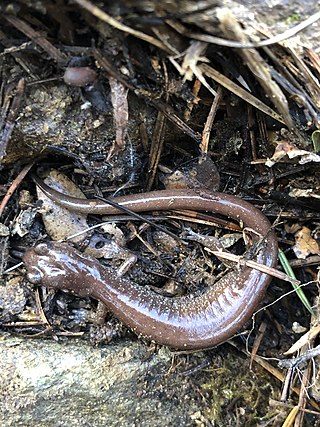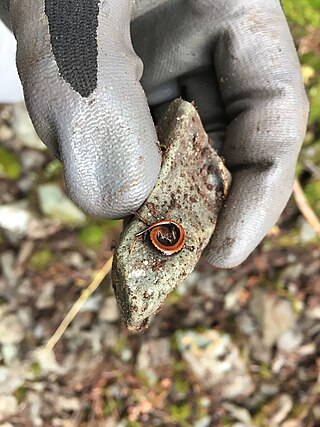
Wehrle's salamander is a species of salamander in the family Plethodontidae. It is endemic to the Eastern United States. It is named in honor of Richard White Wehrle (1852–1937), a jeweler, naturalist, and collector of the holotype.
Oedipina complex, commonly known as the Gamboa worm salamander, is a species of lungless salamander found in western South America from Costa Rica to western Colombia and north-western Ecuador. This species inhabits humid tropical lowland forest where it can be found on the ground, and on bushy vegetation, logs and rocks. It can also be found on forest edges, but it does not survive in degraded areas. Deforestation is a threat to this species.

The northern slimy salamander is a species of terrestrial plethodontid salamander found throughout much of the eastern two-thirds of the United States.

Van Dyke's salamander is a small woodland salamander in the family Plethodontidae, the lungless salamanders. These animals breathe through their skin and are largely terrestrial. Compared to other salamanders in Plethodon it is relatively stocky with long legs. Usually associated with streams, seepages, and rock outcrops, it is endemic to Washington where it is found in a limited number of small, isolated populations.

The Oita salamander is a species of salamander in the family Hynobiidae endemic to Japan. Named after Oita Prefecture, its natural habitats are temperate forests, rivers, intermittent rivers, freshwater marshes, intermittent freshwater marshes, and irrigated land in western Japan. It is threatened by habitat loss, due to the increasing construction of homes within its habitat. The Oita Salamander is considered to be vulnerable by the (IUCN) Red List of Threatened Species with a declining population.

The Sacramento Mountain salamander is a species of salamander in the family Plethodontidae. It is endemic to mountainous regions of New Mexico in the United States. Its natural habitat is temperate forests where it is threatened by habitat loss.

The Oregon slender salamander is a species of salamander in the family Plethodontidae from the Northwestern United States.
Bolitoglossa porrasorum is a species of salamander in the family Plethodontidae. It is endemic to the mountains of north-central Honduras. Common name Pijol salamander has been proposed for this species in reference to its type locality, Pico Pijol. The specific name porrasorum honors of Jorge Porras Ziuniga and Jorge Porras Orellana, father and son, who provided friendship and assistance to the describers of this species.

The Scott Bar salamander is a species of salamander in the family Plethodontidae, endemic to the United States, where it is restricted to a very small range in the Scott River drainage in Siskiyou County, California, at altitudes between 700 and 1,300 metres above sea level. Described in 2005, it is one of the most recently described species in the large genus Plethodon.

The Del Norte salamander is a species of salamander in the family Plethodontidae endemic to the United States in southwestern Oregon and northwestern California.
The valley and ridge salamander is a species of salamander in the family Plethodontidae endemic to the Appalachian Mountains in the eastern United States.
The Kiamichi slimy salamander is a species of salamander in the family Plethodontidae endemic to the United States, has a natural habitat of temperate forests, and is found over a small range. This nocturnal species is mainly threatened by habitat loss and was first described by Highton in 1989. It is rated as a vulnerable species by the International Union for Conservation of Nature.

The Larch Mountain salamander is a species of salamander in the family Plethodontidae endemic to the United States. It occurs in the Cascade Mountains of southern Washington and northern Oregon. In Washington, it occurs from the Columbia River Gorge to just north of Snoqualmie Pass. Its natural habitats are temperate forests and rocky areas. It is threatened by habitat loss.

The northern gray-cheeked salamander is a species of salamander in the family Plethodontidae and endemic to the Blue Ridge Mountains and Appalachian Mountains in the eastern United States. It is closely related to the Red-cheeked salamander and the Red-legged salamander. Its natural habitat is temperate forests. It is found under moss, rocks, logs, and bark in cool, moist forests above 2500 feet. Especially found in spruce-fir forests. The Gray-cheeked Salamander commonly eats millipedes, earthworms, crane flies, spiders, and centipedes and less commonly eats ants, mites, and springtails. They eat spiders, moths, flies, beetles, bees, and snails. The male and female perform a courtship, where the male nudges the female with his snout, does a foot dance, then circles under the female and the two then walk together. Like other salamanders, they do not migrate or aggregate during breeding season. It is threatened by habitat loss.

The western red-backed salamander is a species of salamander in the family Plethodontidae. The species is found in extreme southwestern Canada and the northwestern United States. The western red-backed salamander is found in temperate rainforests of the Pacific Northwest. It is considered widespread in the region and is not strictly associated with a specific habitat type.

Pseudoeurycea lynchi, commonly known as the Veracruz green salamander, is a species of salamanders in the family Plethodontidae. It is endemic to the central Sierra Madre Oriental in Veracruz and Puebla states, Mexico.
Isthmura naucampatepetl, commonly known as the Cofre de Perote salamander, is a species of salamanders in the family Plethodontidae. It is endemic to the Sierra Madre Oriental in central Veracruz, Mexico, where it is known from between Cofre de Perote and Cerro Volcancillo, a satellite peak of Cofre de Perote.
Pseudoeurycea nigromaculata, commonly known as the black-spotted salamander or black-spotted false brook salamander is a species of salamander in the family Plethodontidae. It is endemic to Veracruz, Mexico, and known from Cerro Chicahuaxtla ) in Cuatlalpan and from Volcán San Martín at elevations of 1,200–1,300 m (3,900–4,300 ft). These separate populations likely represent distinct species.
Pseudoeurycea teotepec, commonly known as the Teotepec salamander, is a species of salamander in the family Plethodontidae. It is endemic to Mexico and only known from its type locality, southern slope of Cerro Teotepec in Guerrero, at about 3,425 m (11,237 ft) asl.

Bolitoglossa cataguana, also known as the Cataguana salamander, is a species of salamander in the family Plethodontidae. It is endemic to Honduras and known from near Cataguana in the Marale municipality, Francisco Morazán Department.














